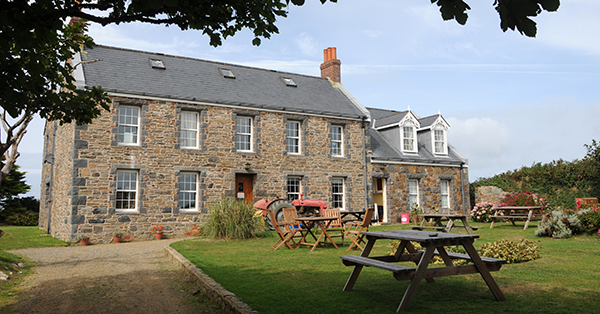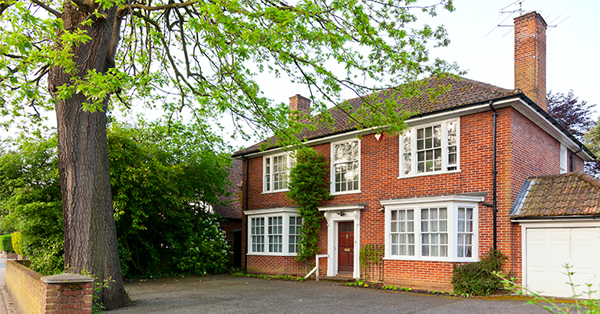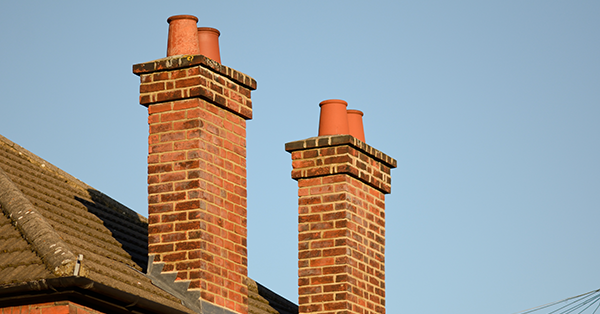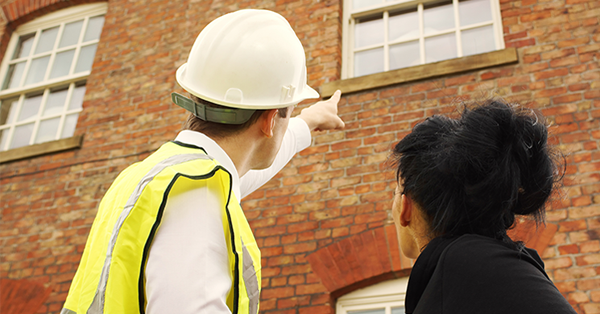Should I Buy a House With a Leaning Chimney Stack?
- The chimney breast supports the overall weight of the chimney and stops it from collapsing, therefore making it, and the stack, a significant structural element of the property.
- Top Tip: Get a professional opinion from a structural surveyor to decide whether the leaning chimney stack should be replaced.
- The foundation beneath a chimney is prone to damage, particularly because chimneys put a lot of weight on the foundation below them.
- Most UK homes have a chimney, but people are regularly getting them removed.
Purchasing a house with a leaning chimney stack can be cause for concern. You might think that it indicates structural issues with the property or that there is a foundation problem.
It's normal for an old chimney stack to slightly lean, but only a structural surveyor or engineer can confirm whether it needs to be rebuilt, removed, or restored.
It's important to properly assess the extent and the most likely cause of the issue before making a purchasing decision. Depending on the severity, it might or might not be worth the investment.

What is a chimney stack?
A chimney stack is an upright structure that extends above the roof of a property, typically comprised of masonry such as brick and stone.
It's constructed to vent smoke from a fireplace, hence its tall and lean composition. It has a flexible flue liner or opening at the top made with clay or metal that helps to prevent deterioration and the safe discharge of smoke and other gases.
In some properties, a chimney pot will sit atop the stack, ensuring a taller smokestack. Chimney pots are made with either clay or terracotta and were popular in the 19th century when people burned coal to heat their homes.
These pots are bonded into the crown brickwork with a cement mix, referred to by builders as haunching. Chimney haunching allows rainwater to run off the stack, stopping the rainwater from pooling up and becoming a problem.

The difference between chimney stacks and chimney breasts
A chimney stack rises above the roof of a building, effectively the only visible part of the chimney from the exterior. It’s made of brick or stone to match the external makeup of the property.
A chimney breast connects the fireplace or stove to the stack of bricks and mortar on the roof. It’s the vertical part found within the building itself and is usually also made of brick, mortar, or stone.
Why is a chimney stack important?
Safety
The stack is a necessary safety feature that helps to block harmful gases and smoke from escaping within a property. Without a stack, the toxic elements gather in the chimney, eventually bleeding out into the building and leaving the occupants at risk.
Efficiency
Chimney stacks are important in maintaining heating systems. Because harmful gases and smoke are being vented outside, the interior air quality lets the heating system work more efficiently.
Structural integrity
The stack supports the overall weight of the chimney and stops it from collapsing, therefore making it a significant structural element of the building.
Aesthetics
Many buildings with chimney stacks are deemed visually appealing, adding a certain character and charm.
Is a chimney inspection included in a Level 3 RICS Survey?
The survey inspects all visible and accessible parts of a property, including chimneys. Since surveyors have a legal responsibility to inform of major problems with a property, any chimney stack defects would be included.
An example of a home survey report referring to chimney stacks can be found below:
It was not raining at the time of inspection and there may be leaks or defects which only become apparent during periods of heavy rain.
There are rendered masonry chimney stacks with metal flashings on the left hand side, which are party structures and sit either side of the apex of the main roof.
flaunchings are not generally visible and these should be checked and repaired if necessary, the next time full and safe access is available.
When does a leaning chimney become a problem?
A leaning chimney doesn't always mean structurally insecure, and neither does the presence of cracks – both are the most common chimney problems in older properties, particularly from 1930s chimney construction in the UK and if the stacks are particularly tall and slender.
One reason why the stacks lean is due to eroded mortar joints. It's believed that the side of the stack exposed to the prevailing wind will dry out more quickly, meaning that the eroded mortar joints shrink whilst the other side expands. This is why we almost always tend to see chimney stacks leaning in towards the centre of a property.

Leaks around a chimney stack can be characterised by brown staining surrounding the brickwork. This can be caused by defective flashings (a thin easily warped material to protect against rain) and cracks in mortar joints between the masonry or bricks.
Correctly installed new lead flashings (a shield coating of lead to seal the joint between the chimney and the roofing) can prevent seepage from rainwater and have been known to last for decades, especially if they are installed to extend higher. This, along with the interlocking tiles on a roof, can assist in the prevention of leaks.
In older houses, there usually isn't a damp proof course (DPC) in stacks. DPC stops rising damp on a wall (one of the most common problems), so without the protection and with potential defective flashings, dampness can soak into the masonry and move downwards into the house.
An otherwise perfectly good flashing can be rendered obsolete if there is no DPC in the stack. When it comes to chimney maintenance, it is a false economy to use cheap materials, but lime plaster has been known to withstand rain water ingress and the effects of masonry salts.
There could also be a problem with your property's foundation. The foundation beneath a chimney is prone to damage, particularly because chimneys put a lot of weight on the foundation below them.
If you live in a conservation area, consent is required from your local planning authority to demolish or reduce a chimney stack.
The same goes for a listed building; you would need to apply for listed building consent from the local planning authority. The removal of a chimney is considered to materially affect the architectural or historic interest of the building.
How this happens could be due to a multitude of reasons, such as:
- Rain – rainwater can leak below your house’s foundation and wear away at the chimney’s support system. This could end with the foundation cracking or separating from the house.
- Time – if the foundation of your house was poorly constructed, the chimney foundation may just simply give way over time.
If either occurs, the chimney has less support which can cause it to lean. This problem can become more pronounced if left untreated.

Since a leaning chimney can be due to foundational issues, you may face a similar problem in other areas of the property too. It could be that the first noticeable area was the stack, and another part of the property has been affected.
Planning to remove a chimney breast?
Whether a chimney breast has been removed or you are planning to remove it, we have a structural engineer to provide the strengthening report required.
Free no obligation quote at competitive prices.
This is why a leaning stack and chimney problems could point to a far more serious structural issue with a property, but please note that this would be an extreme case and it's far more likely that a leaning chimney stack is due to prevailing wind rather than foundational cracks.
Since a chimney stack can lean away from a property for a variety of reasons, even though these reasons can differ greatly, the situation should still be treated as seriously and carefully as possible.
Should I remove my chimney?
It’s becoming increasingly common to have a chimney removed, regardless of the type of property that you have.
The reality is that, due to central heating advancements, chimneys are now thought of as unnecessary. Fireplaces are used far less in modern times, and nowadays people tend to opt for an electric fireplace which does not require a chimney.
Due to costs, getting one removed is no small task and it can end up costing a lot of money. They may be unnecessary, but finances become the focal point of the question now.
Just like anything else, chimneys require regular maintenance. It could get to the point where repairing a chimney costs more than just removing it.

If you’re looking to buy a property with a chimney, it might be a better financial decision to remove it now rather than pay the ongoing maintenance costs over the period that you own it.
What if the chimney breast has already been removed?
Removing the chimney breast but keeping the stack is extremely common. However, removing a load-bearing element of your property requires extra structural supports to ensure the stack is property supported without the breast.
It's always best to consult with a structural engineer on this as they will be able to advise on the best possible course of action for your home.
Pros of chimney removal:
- Less maintenance – no more worries about regular maintenance. You can view the costs and offset them against the money that would have been spent on maintenance.
- More space – chimneys take up space, in particular chimney breasts, and although the stack isn't necessarily in your way being above the roof, having the whole chimney removed can create more space for you in your property.
- Efficiency – although a chimney is designed to help with heating a property, naturally since it’s a big hole, heat will escape and there isn’t much you can do other than removing the stack at least.
- Safety – it doesn't happen often, but chimney pots and stacks have been known to slide off roofs. In extreme weather conditions, the stack is a heavy thing falling from the sky to a walking pedestrian.
Cons of chimney removal:
- The cost – we said it before in this article, but anything involving chimney removal is not cheap. It can be a tough endeavour to take on a big expense when you don't absolutely have to.
- Disruptions – this depends on how much of your chimney you’re having removed, but there will be some disruption to your home life. If it’s just the stack being removed, it can take up to a day, but anything more than that and you will be looking at between 2-4 days.
- Appearance – most UK homes have a chimney, but people are regularly getting them removed. However, a house without a chimney right now will tend to stick out. Whether that’s positive or not is down to the person’s preferences.
- Period features – many buyers see a wood burner or open fire as a significant draw to a property, particularly period properties such as Georgian and Edwardian houses and flats. If you remove the chimney, you (and any future buyers) lose the option to reopen fireplaces or install a log burner in the future.
Jack is our resident Content Writer with a wealth of experience in Marketing, Content, and Film. If you need anything written or proof-read at a rapid speed and high quality, he's your guy.
Caragh is an excellent writer and copy editor of books, news articles and editorials. She has written extensively for SAM for a variety of conveyancing, survey, property law and mortgage-related articles.









